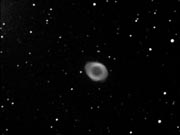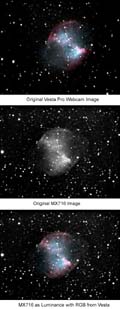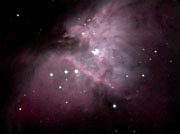Some of these images are quite pleasing, others mediocre to poor depending on the degree of trailing, sky conditions etc. All are linked to enlargements - click on the thumbnail.
MX716 Camera Details here.
Here is a selection of my first images with this camera. I've yet to get to a dark site - all these were taken from my light polluted back yard with various exposures and combinations of filters. I hope to replace them with better (dark sky) shots eventually, and will then post details. The MX series cameras have a self guiding feature, and I'm having mixed success at the moment with my LX90, but starting to get the feel of it!
|
Some of these images are quite pleasing, others mediocre to poor depending on the degree of trailing, sky conditions etc. All are linked to enlargements - click on the thumbnail. |
|||
|
On March 25th (2003) I went for a week at the COAA Astronomy centre in the Algarve, Portugal. Well, it would have been a week if a mechanical fault on my first leg 'plane hadn't caused me to miss my connecting flight, and spend a night in a UK hotel. (At the airline's expense!) Not that I missed much - the first two nights including the one I spent in England were cloudy anyway. But the third evening cleared up and it was all hands to the telescopes! Nevertheless there was a lot of moisture in the air, and heavy dew took it's toll as well as a hazy atmosphere. But the 20" f 4.5 Newtonian proved its worth with these two pictures, the Ringtail Galaxy (NGC 4038) in Corvus and Hoag's Object (PGC 54559) in Serpens. Although it could be mistaken for a planetary nebula, it is in fact a ring Galaxy. It appears to have spokes, also mentioned by Al Kelly: "A distant ring galaxy (PGC 54559) imaged on 6/15/96 with 32" f4 Newtonian and CB245 CCD camera from Danciger, Texas. This is an eleven-minute composite exposure which has been processed with a mild unsharp mask to bring out the faint spoke-like structure within the ring." His image can be seen here. But apart from the second ringed galaxy within the hub space, the Hubble image shows no structure which could account for the spoked appearance. I suspect it to be a processing artifact. There appear to be a couple of small edge-on galaxies in the bottom left hand corner of the image. If anyone can identify them, please let me know. Unfortunately the unusually high humidity robbed the sky of the clarity necessary clearly to show the 'tails'of the Ringtail, but there is a suggestion of them after enhancement. All credit to Bev Ewen-Smith of COAA who did all the donkey work, finding the objects, focussing and guiding the telescope. My contribution was simply to suggest the targets and operate the imaging software. Thanks again, Bev. Ringtail is 3 x 2 minute Hi-res Fast images stacked, Hoag's Object 2 x 2 mins + 2 x 3 mins stacked (binned 2 x 2). All with the MX716 camera. |
|
|
Three images here taken late May / early June . Very poor skies generally, and the lack of full darkness meant all images were affected by haze and skyglow. But just to keep my hand in........ |
|
|
|
|

|

|

|
|
The previous monochrome MX716 image of M27 (above) was crisper and more detailed than my best one on the Webcam page taken with the Vesta Pro camera. So I decided to use the colour information from the Webcam image and apply it to the MX image. Thanks to Greg Beeke for reminding me of the method - an excerpt from his instructions follows. Very effective! Note re the instruction to select all of the RGB image: I just selected part of the image around the nebula itself, with a feathered edge clear of the required area. L+RGB: I use Photoshop, but this should be possible in other
programs as long as the processing software has Layers
functionality. I guess you may need to scale and rotate the RGB image until it is aligned to the luminance image. This can be done with the free transform tools, but first you need to be able to see both images so you can align them. To do this, select the RGB layer and change the opacity slider to about 60%. This lets you see both sets of stars in each layer. FreeTransform should allow you to get a pretty good alignment. Once aligned, select the RGB layer and change the Blending Mode to COLOR and set the opacity back to 100%. You can now adjust the colour balance for the RGB layer to your liking. |
 |
|
Rather nifty, adding colour from a mediocre image to make a better B&W image pretty! So I've done it with my MX716 M42, using the colour info from the Vesta image. Again, very effective (IMHO!)
|
 |
|
Although the night of 9/10 July was a bit hazy - a lot of moisture in the air- it was clear enough for some experimenting with my converted EQ3-2 Mount. So I piggybacked the MX camera and had a go at M31. Nautical twilight, 14 x 1 minute unguided images with the 135 mm lens + IR filter at f5.6 (that seems to stop the halo effect on bright stars) , binned 2 x 2. Negligible trailing on all of the frames. Nice to know I can use this mount as a camera platform for wide angle imaging! But I'll have to make a light shroud for the lens - I'm sure the glow on the left side of the image is nearby lighting shining across the lens. |
 |
|
Scarborough and District star party, August 1-4 2003. I attended this annual event, situated at a dark site in the heart of Dalby Forest in the North York Moors, for the first time this year. Although I missed the first night due to another engagement, we were blessed with beautiful fine weather and the other two nights gave plenty of opportunities for dark sky imaging. At last I was able to really put the MX716 to the test with the following results. All thumbnails linked to 640 x 480 images. All images stacks of several frames. We did do some astronomy, honest! From left to right, Bob, Peter (me), Paul, Dave. With the exception of the M33 image the pictures below, along with an accompanying article, were published in the April-June 2004 issue of Popular Astronomy - the magazine of the SPA. |
|
|
My best yet by far! M27 of course, and nebulosity visible that is rarely shown. LX90 at f6.3 |
|
|
A contrasty M31 with dust lanes shown nicely. 135 mm lens at f4 with Baader IR filter. |
|
|
The Crescent nebula (NGC6888) in Cygnus. LX90 at f6.3 |
|
|
M33 in Triangulum. 135 mm lens at f4 with Baader IR filter. There is a beautiful arc of 10 - 12th magnitude stars visible at the Northern extremity of the galaxy. If not already named, I wish to name this 'The M33 Coronet' as of 8th. August 2003. |
|
|
M16 - the Eagle Nebula. Although at 19 degrees altitude it was higher than when I imaged it from Holy Island (see above) conditions following a hot day were turbulent low down, consequently the stars were rather bloated. But a decent amount of detail and reasonable contrast considering. |
|
|
M17 - the Swan or Omega Nebula. Even lower than M16 at 17 degrees and also subject to poor conditions. But my first image of this object, and I'm quite pleased with it. From this angle I reckon it looks more like the head of the 'Pelican' than a swan! |
|
At the time I took the monochrome MX716 image, I also took three colour frames using ordinary photographic filters in front of the 135 mm camera lens. Overlaying in Photoshop the RGB image from these to provide colour information, a pleasing final result. |
|
Using the same technique as for M31, and as I did with a previous image of M27, I have used the colour information from my webcam image to 'prettify' the monochrome MX716 image. |
|
After a few days of cloud cover, the evening of 13th. August was clear. Just after the Perseid meteor peak, and I wanted to experiment with autoguiding the MX716. But it was breezy and gusty, so I quickly abandoned the autoguide experiment and imaged the Wild Duck (M11) Open Cluster in Scutum and a couple of Globular Clusters - M13 and M92, both in Hercules. The M13 turned out worse than the previous effort on 13th. June, so is not shown here, but M92 was satisfactory. Almost full Moon, but well away from M92. Nevertheless the sky was fairly bright. And I didn't see a single meteor! Both clusters with the LX90 at f6.3 This image of M92 appeared in the July-September 2006 issue of the SPA magazine |
|
Mars has been misbehaving - poor seeing, so no worthwhile images. But some more Messier objects for my collection. All taken in the early hours of 20th. August 2003 from light polluted Boldon with the MX716 camera . LX90 telescope with f6.3 reducer. All images are stacks of several 30 second exposures. Here is M2 - a compact Globular Cluster in Aquarius |
|
|
M15 in Pegasus. This globular cluster unusually contains a planetary nebula, Pease 1, ( PK 65-27.1) |
|
|
M56 in Lyra. Rather a sparse cluster. |
|
|
All those globulars! But here is the nice small open cluster M29 situated just beside the centre of the cross of Cygnus. |
|
Light pollution can be overcome to a certain extent with filters, but although Stephan's quintet was quite high on the night of 29/30 August 2003, nevertheless even with a LPR filter it still lacks contrast. Next time at a dark site.... In Pegasus, MX716 with LX90 at f6.3, binned 2 x 2. Stacked from 45 second images. |
|
On 20th. September, after an afternoon and evening of steady, at times torrential (and much needed!) rain, the skies cleared to excellent clarity. Alas the seeing was poor, so again no Mars, but a decent shot (from light polluted back garden) of NGC 891 in Andromeda. Fortune didn't favour me completely however - my main battery let me down, and I eventually found I was imaging with a dewed corrector plate! Nevertheless, enough good 60 second unfiltered frames (7) to produce this image. MX716, LX90 at f6.3. Colour version using colour from earlier Webcam image. |
|
The early hours of September 21st. were reasonably clear, and I obtained this image of NGC7331, galaxy in Pegasus, complete with four smaller galaxies. MX716, LX90 at f6.3, from my light polluted back garden. With the good contrast of a clear sky from a dark site this grouping will be beautiful...... |
|
After another weather front passed through, again beautiful clear skies on the night of 22-23 September. So I was out in my back garden, fighting the light pollution! MX716 camera with LX90 at f6.3. All images stacked from 1 minute frames. Unfortunately there was a gusty breeze, so only a handful of frames were usable. M110 is usually overlooked as a minor companion of M31 - the Great Galaxy in Andromeda. But a galaxy in it's own right, with an interesting dark patch. 6 frames |
|
|
M1, at last with some filamentary detail. only 4 frames. Fortunately this is a relatively bright contrasty subject. |
|
|
M74, galaxy in Pisces. Very difficult to observe visually - I've only seen it a couple of times through my 8" SCT. But the MX716 picks it out ok, even through light pollution. Only 5 frames useable, so rather grainy, but the spiral arms are clearly visible. |
|
Another fine night on 23-24th. September,and another productive session, this time with less wind, so more frames usable out of each group, but still with light polluted skies. When I get to a permanent dark site (soon!), I'll eventually revisit these objects and hopefully capture better contrast and detail. All images MX716, LX90 at f 6.3, fast high res mode. First , a much better M1 than last night - lots more frames available. |
|
|
M 74 also revisited, smoother and better detail. This image shows the fading Supernova 2003gd (Pointers on enlargement) |
|
|
NGC 185, dwarf elliptical galaxy in Cassiopeia. That is a star belonging to our galaxy in front of the core |
|
|
NGC 7814, galaxy in Pegasus. A very bright core, washing out the dust lane. This deserves higher magnification and a range of exposures to best bring out the structure.
Well, it took 5 years, but I eventually revisited this galaxy with my latest equipment, and out of interest reprocessed the data for this image, again using the newer software and experience of those 5 years. Not so bad! |
|
|
NGC 7479. A beautiful barred spiral in Pegasus. |
|
|
And here is the decent M1 above with colour from my webcam version
|
|
Not much activity of late - clouds, other committments etc. But I've just lashed out on a TMB 105 mm f6.2 APO refractor, and had to try it out! So here is my first decent image with it, taken under poor sky conditions from my back garden on 28th. November (2003) - breezy, cloudy and light polluted. Stack of 7 x 30 second images at prime focus with the MX716 + Baader IR Filter. One of my favourite open clusters - NGC457 in Cassiopiea. It appears elsewhere on my Web pages (Deep Sky Webcams), but this image is far superior. The 'scope was mounted on my EQ3-2. A little bouncy when knocked, but once it settles down the mount carries the tube better than I expected. That mount is well and truly earning its keep! |
|
Another image at prime focus of the TMB. The Great Orion Nebula, Messier 42 and 43 of course, taken in the early hours of 30th November 2003. Location my light polluted back garden at Boldon. Not particularly contrasty although the use of Infra Red and Light Pollution filters helped. The thing is, this was just a single 1 minute unguided exposure on the EQ3-2 mount. The clouds arrived while I was imaging a sequence, and this was the only usable frame. When I processed it (using Photoshop) I was stunned by the amount of detail captured, and the relatively unburnt Trapezium area which has been only slightly adjusted in this image. |
|
Bright Open Clusters image well from a light polluted location - the point source stars are not seriously compromised by the skyglow, although the background can be affected. This image of the central region of Messier 34 in Perseus on 17th. December 2003, is a stack of 10 x 30 second MX716 frames, LX90 at f6.3. No filters. This image appeared in the October-December 2008 issue of the SPA magazine |
|
The night of 28-29 December was crisp and clear. This M42 image was taken using the Stellarvue 80 mm refractor, MX716 camera at prime focus with Light Pollution Filter. I mistakenly fitted a clear glass filter instead of the Infra Red filter, so the stars are a little bloated. Must do better!! Still some sky glow getting through at my light polluted Boldon location, but I'm moving house shortly! Early hours of 29th. December. 8 x 1 minute exposures. Larger area of course and a bit more detail than the earlier TMB, but that was still surprisingly good for one frame. |
|
Here is a Messier 103 I hadn't posted. It was an experimentally self guided exposure using the AT1010 refractor on the EQ3-2 mount with guiding via Autostar. Single 10 minute exposure, equivalent to 5 minutes unguided. It will suffice until I get a better one! Imaged just after midnight - the early hours of November 11th. 2003 at Boldon. A successful guide I think! |